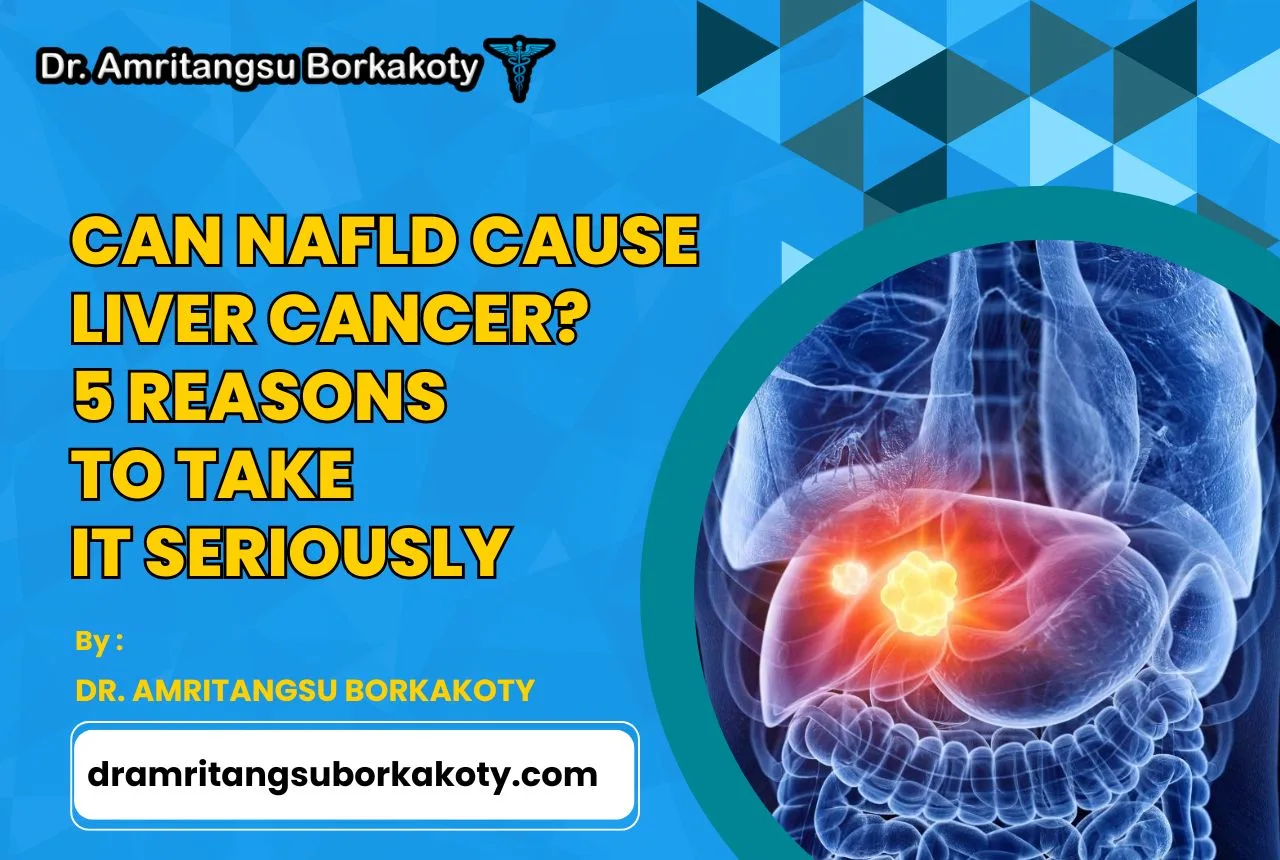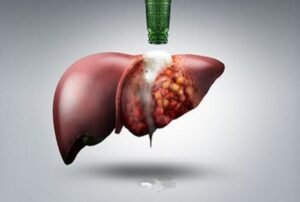
-
Posted By Rashmi Sarmah
-
-
Comments 0
Non-alcoholic fatty liver disease (NAFLD) is a growing global health concern, and many are now asking, can NAFLD cause liver cancer? This condition affects individuals who consume little to no alcohol and is characterized by excess fat buildup in the liver, often linked to obesity, insulin resistance, and metabolic syndrome.
Alarming research shows that NAFLD now impacts nearly 25% of adults in the United States and is becoming increasingly common worldwide, including in countries like India.
While NAFLD may seem benign in its early stages, it can silently evolve into serious health complications—with liver cancer being one of the most devastating outcomes. So, can NAFLD cause liver cancer? The answer is yes, and the risks are far greater than most people realize.
This blog explores the strong link between NAFLD and liver cancer, highlighting five crucial reasons why early detection and lifestyle changes are essential. Understanding the risks could be the first step toward protecting your long-term liver health.
Can NAFLD Cause Liver Cancer? Understanding the Connection
NAFLD begins as simple liver fat accumulation but can progress to non-alcoholic steatohepatitis (NASH)—a more severe form involving inflammation and liver cell damage. NASH can lead to fibrosis, cirrhosis, and eventually hepatocellular carcinoma (HCC), the most common type of liver cancer.
According to current studies, individuals with NAFLD face a 17-fold increased risk of developing HCC compared to those without the condition. Unlike traditional liver cancer causes such as hepatitis B or alcohol abuse, NAFLD-related liver cancer can occur even in the absence of cirrhosis.

This progression stems from the pathophysiological cascade initiated by fat accumulation: oxidative stress, chronic inflammation, and fibrogenesis all play a role in cellular mutations that lead to cancer.
“NAFLD is no longer a silent disease,” says Dr. Amritangsu Borkakoty, leading Liver Specialist in Guwahati. “It is now one of the top contributors to liver cancer globally, even in patients who appear otherwise healthy.”
5 Eye-Opening Reasons to Take NAFLD Seriously
1. NAFLD Can Progress to Cancer Even Without Cirrhosis
One of the most concerning findings in recent liver research (2024–2025) is that liver cancer can develop in patients without cirrhosis. Even those with mild or moderate fibrosis have shown cancerous changes.
This is due to the “multi-parallel hit” theory, where multiple metabolic, genetic, and inflammatory triggers work simultaneously to promote liver damage and tumor development.
2. NAFLD Increases Risk of Multiple Cancer Types
Beyond liver cancer, NAFLD has been associated with increased risks of colorectal, pancreatic, kidney/bladder cancers, and even melanoma.
The chronic systemic inflammation and insulin resistance seen in NAFLD can promote cancer cell growth in various organs, making it a multi-organ risk factor.
3. The Silent Nature of NAFLD Makes Early Detection Difficult
NAFLD often progresses without noticeable symptoms, even in its more advanced stages. This makes it difficult to detect early, when interventions are most effective.
Patients are often diagnosed incidentally or only after significant liver damage has occurred—by which time the risk of cancer has already escalated.
4. NAFLD-Related Cancer Has Limited Treatment Options
Once liver cancer develops from NAFLD, treatment options become limited. Surgery, liver transplant, or targeted therapies may be necessary—but these are often available only in advanced healthcare settings and have variable success rates.
Dr. Borkakoty emphasizes, “By the time cancer is diagnosed, the liver may already be too compromised for curative treatment.”
5. NAFLD Prevalence is Rapidly Increasing Worldwide
As of 2025, NAFLD affects nearly 1 in 4 people globally, driven by rising obesity rates, sedentary lifestyles, and unhealthy diets.
With its exponential growth, NAFLD has emerged as one of the leading public health threats of our time, particularly because of its link to life-threatening diseases like liver cancer.
How to Reduce Your NAFLD-Related Cancer Risk
If you’re concerned about NAFLD, taking proactive steps today could save your life tomorrow. Here’s how:
- Adopt a liver-friendly diet: Focus on whole foods, fiber-rich vegetables, lean proteins, and avoid added sugars and processed foods.
- Exercise regularly: Aim for at least 150 minutes of moderate-intensity physical activity per week.
- Maintain a healthy weight: Even modest weight loss (5-10%) can significantly reduce liver fat and inflammation.
- Avoid alcohol: It can exacerbate liver damage and accelerate cancer risk.
- Consider medical therapy: Some medications can help control NAFLD in high-risk individuals under medical supervision.
- Regular screening: Those with risk factors like obesity, diabetes, or family history of liver disease should undergo periodic liver health assessments.
Dr. Amritangsu Borkakoty advises, “Prevention and early detection remain our best defense against NAFLD-related liver cancer. Don’t wait for symptoms—get screened if you’re at risk.”
When to See a Doctor About NAFLD
You should consult a doctor if you experience:
- Persistent fatigue
- Unexplained weight loss
- Upper abdominal discomfort
- Elevated liver enzymes in routine blood work
High-risk individuals—especially those with diabetes, obesity, or metabolic syndrome—should undergo liver ultrasound, fibroscan, or MRI, along with blood tests to monitor liver function. Regular checkups with a liver specialist like Dr. Amritangsu Borkakoty can help detect problems early and prevent cancer development.
Can NAFLD Cause Liver Cancer? 5 Reasons to Take It Seriously
So, can NAFLD cause liver cancer? The evidence is overwhelming—yes, it can. NAFLD is no longer a benign condition; it’s a silent epidemic that can lead to life-threatening complications like liver cancer. Taking NAFLD seriously through lifestyle changes, regular screenings, and medical intervention is key to preventing irreversible damage.

Don’t wait—consult a liver specialist today and take the first step towards protecting your liver and your life.
FAQs About NAFLD and Liver Cancer
Can NAFLD be reversed?
Yes. In early stages, lifestyle changes like diet and exercise can reverse fatty liver.
How is NAFLD-related liver cancer treated?
Options include surgery, liver transplant, ablation therapy, or chemotherapy, depending on cancer stage.
What’s the difference between NAFLD and NASH?
NAFLD is fat buildup in the liver, while NASH includes inflammation and cell damage, with a higher cancer risk.
Can children develop NAFLD and related liver cancer?
Yes. Pediatric NAFLD is rising due to poor diets and obesity in children.
How often should someone with NAFLD be screened for liver cancer?
High-risk individuals should undergo liver imaging and blood tests every 6–12 months as per medical guidance.
Recent Posts
- Common Causes of Stomach Ulcers and Effective Treatment Options
- Early Symptoms of Liver Damage: How to Spot the First Warning Signs Before It’s Too Late
- Best Treatment for Hepatitis B and C: Your Complete Guide to Symptoms, Care, and Prevention
- How to Reduce Liver Inflammation Fast: 5 Proven Tips for Rapid Liver Recovery
- Why You Shouldn’t Ignore NAFLD: 5 Shocking Health Risks You Need to Know



